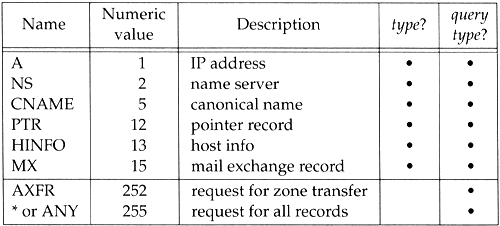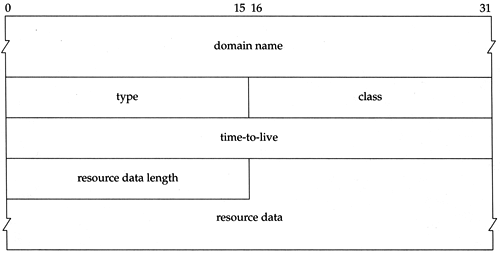14.3 DNS Message Format
14.3 DNS Message Format
There is one DNS message defined for both queries and responses. Figure 14.3 shows the overall format of the message.
Figure 14.3. General format of DNS queries and responses.

The message has a fixed 12-byte header followed by four variable-length fields.
The identification is set by the client and returned by the server. It lets the client match responses to requests .
The 16-bit flags field is divided into numerous pieces, as shown in Figure 14.4.
Figure 14.4. flags field in the DNS header.
We'll start at the leftmost bit and describe each field.
-
QR is a 1-bit field: 0 means the message is a query, 1 means it's a response.
-
opcode is a 4-bit field. The normal value is 0 (a standard query). Other values are 1 (an inverse query) and 2 (server status request).
-
AA is a 1-bit flag that means "authoritative answer." The name server is authoritative for the domain in the question section.
-
TC is a 1-bit field that means "truncated." With UDP this means the total size of the reply exceeded 512 bytes, and only the first 512 bytes of the reply was returned.
-
RD is a 1-bit field that means "recursion desired." This bit can be set in a query and is then returned in the response. This flag tells the name server to handle the query itself, called a recursive query. If the bit is not set, and the requested name server doesn't have an authoritative answer, the requested name server returns a list of other name servers to contact for the answer. This is called an iterative query. We'll see examples of both types of queries in later examples.
-
RA is a 1-bit field that means "recursion available." This bit is set to 1 in the response if the server supports recursion. We'll see in our examples that most name servers provide recursion, except for some root servers.
-
There is a 3-bit field that must be 0.
-
rcode is a 4-bit field with the return code. The common values are 0 (no error) and 3 (name error). A name error is returned only from an authoritative name server and means the domain name specified in the query does not exist.
The next four 16-bit fields specify the number of entries in the four variable-length fields that complete the record. For a query, the number of questions is normally 1 and the other three counts are 0. Similarly, for a reply the number of answers is at least 1, and the remaining two counts can be 0 or nonzero.
Question Portion of DNS Query Message
The format of each question in the question section is shown in Figure 14.5. There is normally just one question.
Figure 14.5. Format of question portion of DNS query message.

The query name is the name being looked up. It is a sequence of one or more labels. Each label begins with a 1-byte count that specifies the number of bytes that follow. The name is terminated with a byte of 0, which is a label with a length of 0, which is the label of the root. Each count byte must be in the range of 0 to 63, since labels are limited to 63 bytes. (We'll see later in this section that a count byte with the two high-order bits turned on, values 192 to 255, is used with a compression scheme.) Unlike many other message formats that we've encountered , this field is allowed to end on a boundary other than a 32-bit boundary. No padding is used.
Figure 14.6 shows how the domain name gemini.tuc.noao.edu is stored.
Figure 14.6. Representation of the domain name gemini.tuc.noao.edu.

Each question has a query type and each response (called a resource record, which we talk about below) has a type. There are about 20 different values, some of which are now obsolete. Figure 14.7 shows some of these values. The query type is a superset of the type: two of the values we show can be used only in questions.
Figure 14.7. type and query type values for DNS questions and responses.

The most common query type is an A type, which means an IP address is desired for the query name. A PTR query requests the names corresponding to an IP address. This is a pointer query that we describe in Section 14.5. We describe the other query types in Section 14.6.
The query class is normally 1, meaning Internet address. (Some other non-IP values are also supported at some locations.)
Resource Record Portion of DNS Response Message
The final three fields in the DNS message, the answers, authority, and additional information fields, share a common format called a resource record or RR. Figure 14.8 shows the format of a resource record.
Figure 14.8. Format of DNS resource record.

The domain name is the name to which the following resource data corresponds. It is in the same format as we described earlier for the query name field (Figure 14.6).
The type specifies one of the RR type codes. These are the same as the query type values that we described earlier. The class is normally 1 for Internet data.
The time-to-live field is the number of seconds that the RR can be cached by the client. RRs often have a TTL of 2 days.
The resource data length specifies the amount of resource data. The format of this data depends on the type. For a type of 1 (an A record) the resource data is a 4-byte IP address.
Now that we've described the basic format of the DNS queries and responses, we'll see what is passed in the packets by watching some exchanges using tcpdump.
EAN: 2147483647
Pages: 378
- Using SQL Data Manipulation Language (DML) to Insert and Manipulate Data Within SQL Tables
- Creating Indexes for Fast Data Retrieval
- Using Keys and Constraints to Maintain Database Integrity
- Understanding Transaction Isolation Levels and Concurrent Processing
- Exploiting MS-SQL Server Built-in Stored Procedures